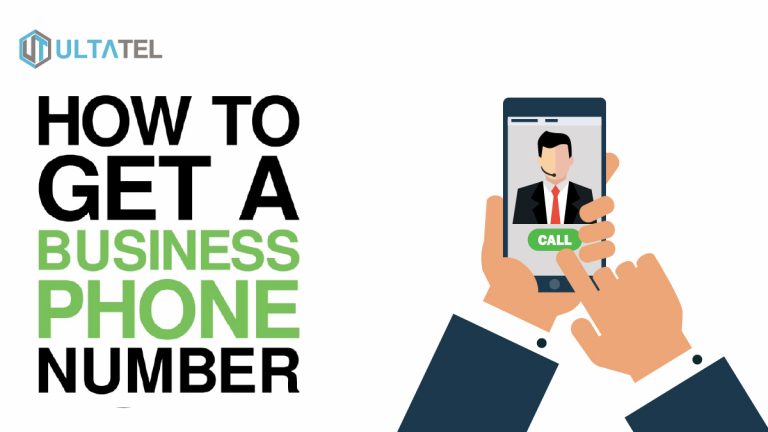Contrary to popular belief, over-the-phone customer service is not dead. In fact, phoning in for queries and troubleshooting can be more efficient than using a chatbot or sending back-and-forth emails. Thus, companies without a business phone number should consider enrolling one.
Business telephone numbers also work wonders for closing sales, receiving customer feedback, and doing market research. In this comprehensive guide, you’ll learn how to get a business phone number, how it works, and how much it costs.
What is a Business Phone Number?
Business phone numbers are for communication with a business or organization. Businesses use these numbers to connect customers, clients, partners, and other stakeholders to the company’s representatives for various purposes, such as inquiries, support, sales, and general communication.
Companies can choose from landline numbers provided by traditional telecommunication companies or virtual phone numbers offered by cloud-based communication services.
Types of Business Phone Numbers
Each business phone number serves various purposes and has differing features. Here are the different types of business phone numbers:
- Local phone numbers: These numbers adhere to a local area code specific to a particular geographic location. Through local phone numbers, businesses establish a local presence and cater to customers in a specific region.
- Toll-free numbers: These numbers allow customers to call a business without incurring charges. In the United States, common toll-free prefixes include 800, 888, 877, 866, 855, and 844. Companies use toll-free numbers for customer support, sales inquiries, and marketing.
- Vanity numbers: These customized phone numbers spell out a specific word or acronym using the alphanumeric keypad. For example, you might see 1-800-FLOWERS or 1-888-PIZZA. These numbers are easy to remember, which can benefit branding and marketing efforts.
- Virtual phone numbers: These numbers aren’t tied to a physical phone line. Instead, they are cloud-hosted, compatible with any existing phone system. Virtual numbers are flexible and popular for businesses wanting to establish a presence in multiple locations without maintaining physical offices.
- International phone numbers: International phone numbers are useful for businesses operating in multiple countries. These numbers have country-specific codes and enable customers from different countries to contact the company without making an international call.
- Direct Inward Dialing (DID) numbers: DID numbers are used in private branch exchange (PBX) systems to assign specific extensions or direct lines to individual employees or departments within a company. They allow external callers to dial a direct number to reach a particular person or team.
- VoIP phone numbers: VoIP (Voice over Internet Protocol) phone numbers use the internet to transmit voice calls. They are an alternative to traditional landline numbers and can offer cost savings, flexibility, and advanced features like call routing and virtual voicemail.
- Emergency Services numbers: In some countries, specific phone numbers are emergency services numbers, such as 911 in the United States. Businesses may have to comply with emergency service access regulations, primarily if they use a VoIP or virtual phone system.
- Sequential dialing numbers: These numbers are standard in call centers or telemarketing campaigns for automatic dialing in sequential order for outbound sales or lead generation purposes.
Why You Need a Business Phone Number
Business phone numbers may seem frivolous if you already employ chatbots on your website. However, they can provide dozens of unexpected benefits, including the following:
- They establish professionalism: Business phone numbers differentiate your communications from personal calls, instilling trust and credibility in your customers and partners. This separation improves organization and ensures recipients can make essential business calls amid private conversations.
- They are accessible to customers: You can enhance customer service by offering a dedicated channel for inquiries, support, and feedback, increasing customer satisfaction.
- They are powerful branding tools: Customers can easier recall your contact information and retain your brand identity in their minds.
- They can establish local presences if you operate in multiple locations: Local business numbers create a sense of familiarity and trust with customers in those regions.
- They prevent unnecessary charges: Thanks to toll-free numbers, customers won’t have to worry about potential costs, encouraging them to reach out for inquiries, support, or placing orders.
- They route and forward calls to the right people: Business phone systems ensure calls go to the correct departments or employees, improving efficiency and customer service.
- They are flexible, scalable, and mobile: Modern business phone systems, including VoIP and virtual phone numbers, are highly adaptable. Employees can make and receive business calls from anywhere with an internet connection, making remote work more feasible.
- They provide analytics and resorts: Advanced phone systems provide insights into call volume, peak times, and customer interactions. Handlers can use this data to improve customer service and optimize business processes.
- They integrate with vital communication tools: Business phone numbers integrate with other communication tools like CRM systems, email clients, and team collaboration platforms, streamlining workflows and enhancing productivity.
When to Get a Business Phone Number
You should consider getting a business phone number as soon as you start or plan to start a business, as it can provide immediate benefits. Here are some other specific situations when you should get a business phone number:
- You need to separate personal and business communications: Suppose you operate a small home-based business. If you use your personal phone number to take business calls, getting a separate number can improve organization and ensure you don’t miss critical calls.
- Your business is expanding to multiple locations: Getting local phone numbers for each area can help establish a local presence and cater to customers in those locations.
- You’re getting more calls: Having a business phone number with call routing and forwarding capabilities can help you handle a growing number of calls more efficiently.
- You’re launching a new marketing campaign: A dedicated business phone number can help track the effectiveness of various sales campaigns.
- You employ employees remotely: A virtual business phone number or VoIP solution can enable seamless communication among team members regardless of their location.
How Much Does It Cost to Set Up a Business Phone Number?
The cost of setting up a business phone number varies depending on the type of phone number, the service provider, the features and functionalities you require, and the country or region in which you operate. Generally, a company phone number can cost between $20 and $30 per user per month. Physical setups typically cost more, while virtual phone systems are often more affordable, as they don’t require hardware.
What Features Should Your Business Phone Number Have?
The features your business phone number should have will depend on your operating goals and the nature of your business. However, most business phone numbers boast the following features:
- Call forwarding: Route incoming calls to different phone numbers to ensure calls are answered promptly by the right person, even if they are not at their desk or are working remotely.
- Voicemail: Receive messages from callers when your team members are unavailable.
- Call recording: Use recorded calls for training purposes, quality assurance, and compliance with regulations.
- Interactive Voice Response (IVR): Enable automated menus to route calls to the appropriate department or provide relevant information to callers and streamline the call process.
- Conference calling: Allow multiple participants to join a call for team meetings, client consultations, and group collaborations.
- Call analytics and reporting: Get insights into call volumes, peak times, call duration, and other metrics to optimize business communication.
- Business hours and call routing: Set specific business hours during which calls are automatically forwarded to specific destinations, such as voicemail or an after-hours support team.
- Toll-free numbers: Allow customers to call your business without incurring charges to make it easier for them to reach out.
- Local phone numbers: Create a local presence and build trust with your audience from a specific region.
- Mobile and remote access: Connect to your business phone system to make and receive calls from anywhere with an internet connection.
- Integration with CRM and productivity tools: Integrating your business phone system with customer relationship management (CRM) software and other productivity tools can streamline workflows and enhance customer interactions.
- Auto attendant: Greet callers and offers menu options for different departments or services to improve call handling efficiency and professionalism.
- Call transfer: Allow employees to transfer calls to other team members or departments to facilitate better collaboration and customer support.
- Text messaging (SMS): Enable customers to send inquiries or receive updates via SMS.
- Call screening and blocking: Block unwanted calls and screen callers before accepting their calls to reduec disruptions and spam calls.
Tips When Choosing a Business Phone Number
Choosing the right business phone number is essential for effective communication with your customers and partners. Here are some tips to consider when selecting a business phone number:
- Decide on the type of business phone number that best suits your needs: Options include local numbers, toll-free numbers, vanity numbers, virtual numbers, and international numbers. Each type has its advantages, so consider the preferences and locations of your target audience.
- Choose a memorable phone number: Make it easy for consumers and team members to remember your phone number to reinforce your brand.
- Pick the features that will benefit your business most: Consider what matters most—is it call forwarding? Voicemail? Do you need an auto attendant to redirect a growing number of calls?
- Consider costs: Compare the costs and pricing structures of different phone number providers. Consider monthly subscription fees, call rates, and any additional charges for specific features or usage.
- Determine what business tools require integration: If you use customer relationship management (CRM) software or other communication tools, choose a business phone service that integrates seamlessly with these tools.
- Opt for mobile accessibility: Get a business phone service that offers mobile apps or web-based interfaces to enable your team to make and receive business calls on the go.
- Review state and country regulations: Ensure that your chosen phone number service complies with any relevant regulations and requirements in your industry or country.
- Take advantage of free trials or demos to test the service before committing: Free trials allow you to evaluate performance and features to ensure the system meets your business needs.
How to Get a Phone Number for Your Business
Choose a Business Phone Number
Decide on the type of number you need (local, toll-free, etc.), and consider a memorable or vanity number if it aligns with your branding strategy.
Purchase Your Business Phone Number
Select a reliable service provider that offers the features you require, and sign up for a plan that suits your business needs and budget. Read customer reviews and testimonials before committing to a supplier long-term.
Set Up Your Business Phone Number
Follow the provider’s instructions to set up your business phone system, configure call routing, voicemail, and other settings to ensure smooth communication. Some providers facilitate the setup process for you.
Optimize Your Business Phone Calls
Train your team on proper call handling, use call analytics to gain insights, and integrate your phone system with other tools to enhance productivity and customer experience.
Get Your Business Phone Number Today
Whether you’re new to the business scene or are an established name looking to build credibility, getting a company phone number has its benefits. Business phone numbers are essential for streamlining queries, connecting team members, improving communications, and keeping customers happy.
When choosing a business phone number, you’ll want to ensure it’s memorable, has the appropriate features your business needs, and comes from a reliable provider.
ULTATEL provides the best VoIP phone system for business owners of all niches. Not only are our systems affordable and easy to set up but are developed for longevity and usability.

